Tết (Vietnamese Lunar New Year) is just around the corner, and as an overseas Vietnamese, it always tugs at my heartstrings a bit because I can’t always make it back home for the festivities. Nevertheless, Tết holds a special place in the hearts of most Vietnamese.
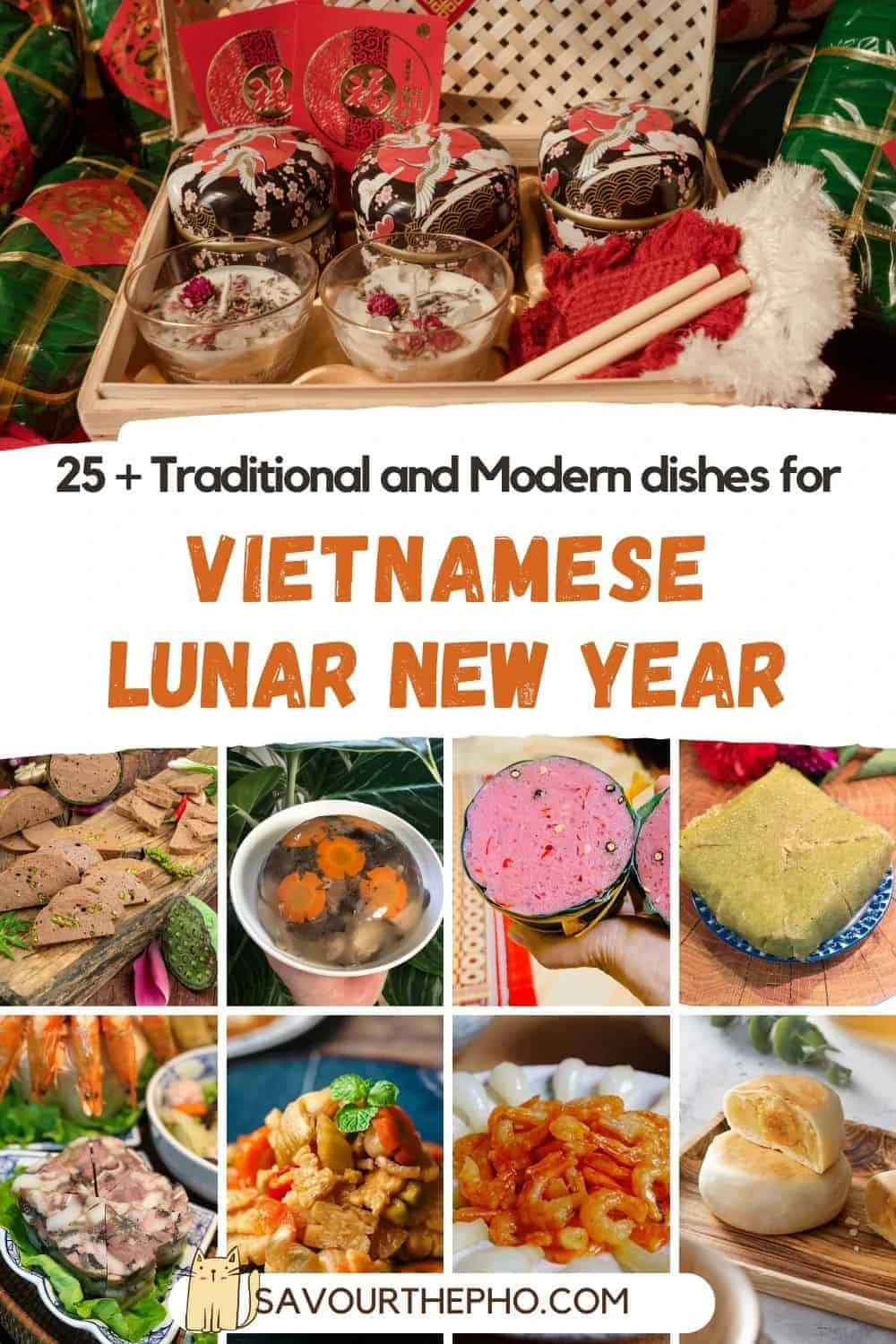
Today, I would like to share with you all a glimpse of what Tet food is like for us, from the North to the Central and the South. There’s quite a difference in eating culture among the three regions in Vietnam.
I’ve also got some recommended recipes on my blog for Tết – they might not all be traditional, but trust me, they’re perfect for bringing everyone together during the Tết celebration.
Table of Contents
Vietnamese Lunar New Year – Tết Nguyên Đán
Tết (or Tết Nguyên Đán) is the Vietnamese Lunar New Year. While it coincides with Chinese New Year and Korean New Year, the Vietnamese celebrate Tết with our cherished traditions.
This festive occasion marks the arrival of spring according to the lunar calendar, typically occurring between late January and mid-February. Tết is a special time dedicated to family reunions, honoring ancestors, and embracing new beginnings. That’s why we affectionately refer to it as “Tết Đoàn Viên” or “Reunion Tết”.

Viet people have a deep affection for Tet food, and that’s why we often refer to celebrating Tet as “Ăn Tết”, literally meaning “eat Tet”.
My parents shared stories from their childhood, during the post-war period when many Vietnamese faced economic hardships. Tết was the only time throughout the year children could receive new clothes. Families would butcher the pig they had raised throughout the year to prepare the festive food for Tết.
When it comes to sweet treats, our traditions are quite similar throughout the North, Central, and South regions. People across the country prepare a 5-fruit tray (mâm ngũ quả) to offer prayers to the ancestors.
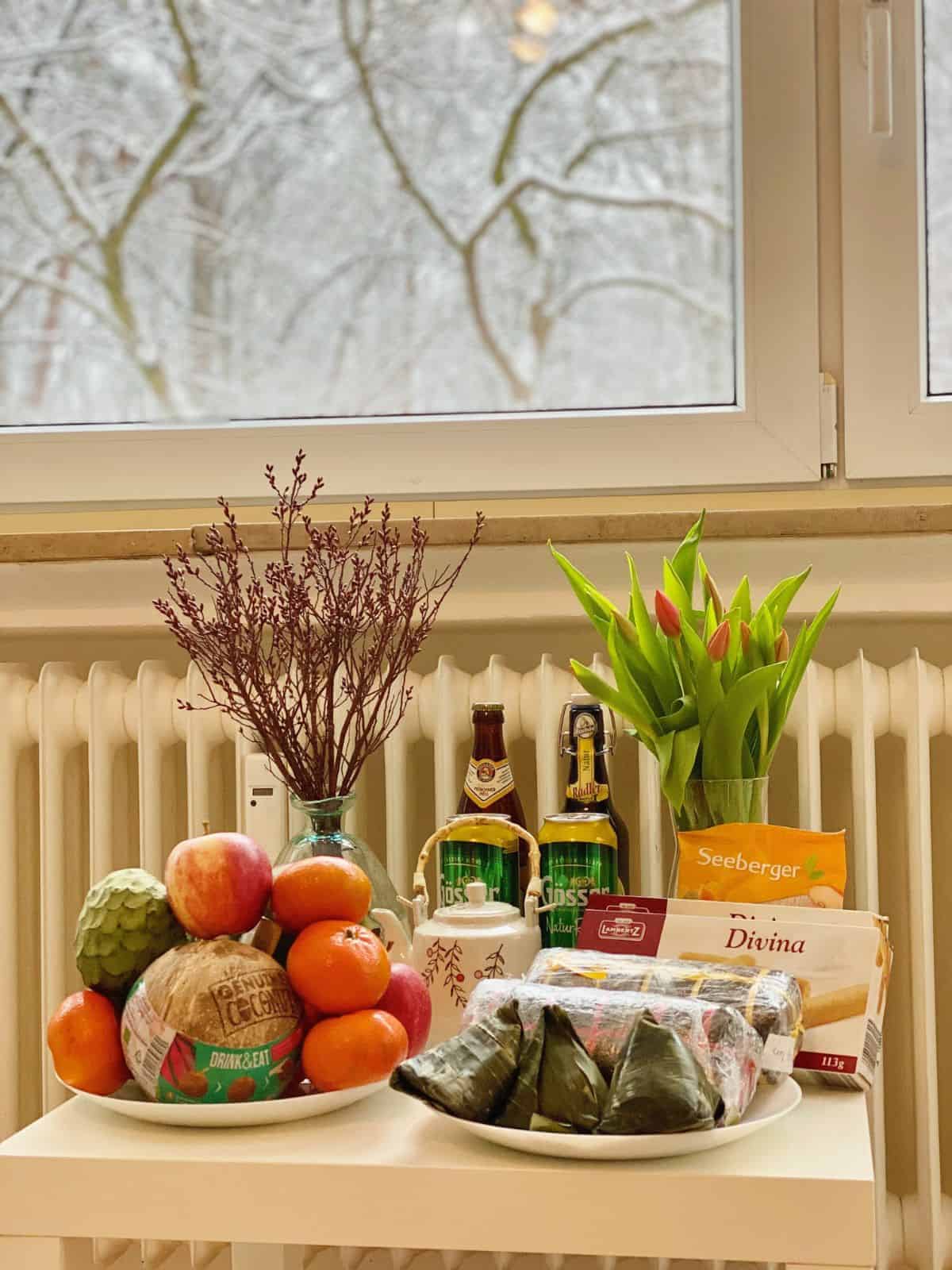
As family and friends make their way from one home to another to celebrate the various days of Tet (Đi Chúc Tết), throughout the festive season, we enjoy mứt Tết (preserved and candied fruits), seeds & nuts with ample cups of tea.
For the traditional savory dishes, the food varies considerably from the North to the South. Born in Nha Trang, a province in the South Central Coast region, and with parents originally from the North, I find myself so lucky to experience the culinary delights from both ends of the country.
Northern Dishes
- Bánh Chưng (Square Sticky Rice Cake)
In Vietnamese history, Bánh Chưng is credited to Lang Liêu, a prince of the last Sixth Hùng Dynasty (c. 1712 – 1632 BC). There’s no doubt that it is the traditional essential treat for Tet. In the North, it’s a must-have, while in the South, people prefer Bánh Tét , a similar dish but in a cylindrical shape.

Made from sticky rice and filled with mung beans and pork belly, Bánh Chưng is typically wrapped in lá dong . Since lá dong is challenging to find outside the country, overseas Vietnamese often use lá chuối (banana leaves) to wrap Bánh Chưng.
In my family, we usually prepare both Bánh Chưng and Bánh Tét, but my dad prefers presenting Bánh Chưng on the altar because they look more appealing.

How to enjoy Bánh Chưng?
In the North, people love to enjoy Bánh Chưng with Dưa Hành (pickled shallots).
In the South, people love to enjoy Bánh Chưng & Bánh Tét with Củ Kiệu (pickled Chinese onions).
As for me, I love to eat Bánh Chưng with Dưa Món (pickled veggies in fish sauce) or with Korean Kimchi.

Nem Rán, a beloved Hanoi street food, is also a must-have for a Tet banquet. My friends up North always jokingly complain about having to wrap a hundred Nem Rán rolls to prepare for Tết, lol.

The filling for Nem Rán differs from Chả Giò (Saigon-style Spring Rolls). It includes ground pork, wood ear mushrooms, mung bean sprouts, mung bean thread noodles, and, especially, cilantro, all wrapped in rice papers.
Dip them into Hanoi-style fried spring rolls dipping sauce , and your taste buds will thank you.

- Gà Luộc (Boiled Chicken)
A gorgeous yellow-skinned boiled chicken isn’t just a dish – it’s a symbol at Tet banquets in the North, representing purity and the ultimate offering to our ancestors.

For Gà Luộc, we opt for free-range or walking chicken (Gà Đi Bộ). We prefer the chicken with slightly chewy texture over the soft and tender one in Instant Pot Hainanese chicken rice.
To be honest, Gà Luộc isn’t everyone’s favorite due to its somewhat bland taste. This usually leaves us with plenty of boiled chicken, and that’s when Vietnamese moms kick into creative mode, coming up with new dishes.
Nothern people often turn these leftover chicken into Bún Thang (noodle soup with chicken, chả lụa, and fried eggs) – a clever creation to finish off all the Tet leftovers.
In my family, my mom loves using Gà Luộc to whip up Phở Gà (Chicken Phở), Cơm Gà (Vietnamese Chicken Rice), Gỏi Gà (Vietnamese Chicken Salad), Gỏi Cuốn Gà (Chicken Spring Rolls) . They’re incredibly tasty.
In the North, Giò Lụa is what they call Chả Lụa (Vietnamese Pork Roll). Though they share similarities, the flavor in the North tends to be a bit less sweet.
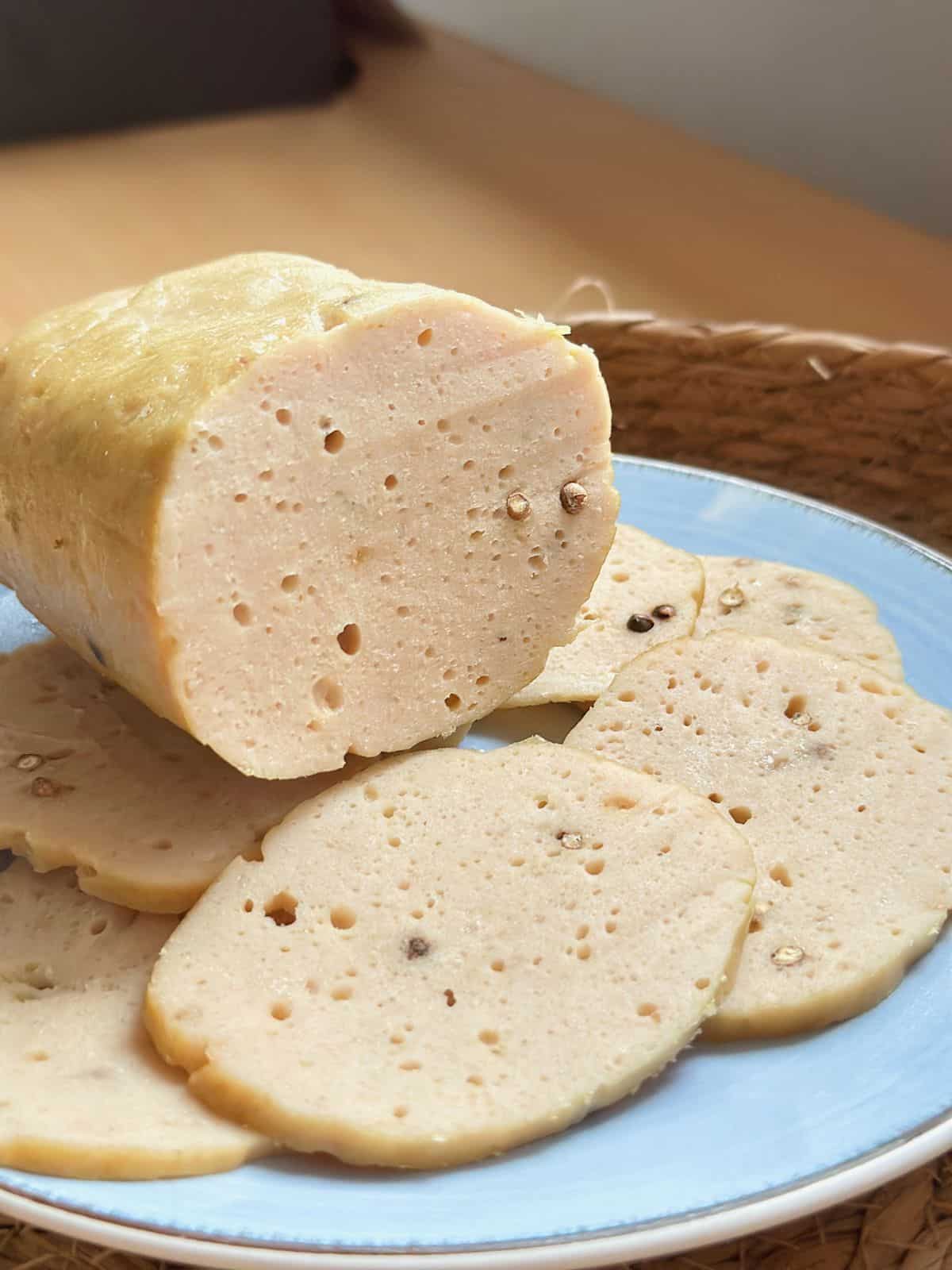
Giò Lụa / Chả Lụa is a convenient dish, ideal for Tet parties, as a snack with drinks, or even as a hassle-free option when people are too busy to cook during Tet.
It’s also commonly served with Banh Mi Sandwiches and Bánh Cuốn (steamed rice rolls).

- Giò Thủ (Vietnamese Head Cheese)
Giò Thủ / Giò Xào is another convenient dish during Tet in the North. “Thủ” translates to “head,” while “xào” means “stir-fry”.
As I mentioned earlier, in the past, Vietnamese families used to butcher a whole pig to celebrate Tet. Giò thủ is a dish where Vietnamese make use of the challenging-to-cook parts of the pig like ears, tongue, cheeks, and snouts.
The meat is stir-fried with wood ear mushrooms, fish sauce, plenty of peppercorns, and then wrapped in banana leaves in a cylindrical shape.

- Thịt Đông (Meat Jelly/Aspic)
Thịt Đông shares some similarities with 猪脚冻 in Chinese Teochew cuisine and various Aspic dishes in Eastern European cuisines.
The primary ingredients for this dish include pork (mainly pork hocks, along with pork rind or ears), wood ear mushrooms, and shiitake mushrooms. The gelatin from the pork skin is crucial for solidifying the aspic and maintaining its shape.

At times, people also make it with chicken, but they need to incorporate some pork skins or packaged gelatin to help it solidify.
My dad shared that when he was a kid, even though our family didn’t have a fridge, the low winter temperatures in the North allowed the aspic to set, and everyone could enjoy the dish during Tet holidays.
Thịt Đông pairs wonderfully with a bowl of steamed rice. (my microwaved jasmine rice could help !!)
For me, thịt đông is somewhat similar to giò thủ in terms of flavors, but I prefer Giò Thủ for its texture.
- Xôi Gấc (Gac Fruit Sticky Rice / Vietnamese Red Sticky Rice)
Xôi gấc (gấc sticky rice) is a staple on the Vietnamese Tết table, particularly in the North.

Gấc Fruit, also known as baby jackfruit, is a Southeast Asian gem rich in lycopene and β-carotene, making it a superfood. The seeds are encased in a thick, incredibly vibrant red-orange membrane, giving Xôi Gấc its eye-catching red-orange color.
In Vietnamese culture, red is considered the lucky color. It symbolizes prosperity, happiness, and good fortune. Hence, during Tet, we deck our houses in red decorations and hand out red envelopes with lucky money to the kids.
While Xôi Gấc is delightful on its own, I personally love enjoying it with some savory dishes like:
- Canh Bóng Thả (Pork Rind Soup)
Canh bóng thả is an indispensable traditional dish for the Tet banquet in Hanoi.

This delightful light soup features an umami broth perfectly complemented by dried pork rind, pork meatballs, and dried shrimps. It also includes shiitake mushrooms and meticulously carved veggies like carrots, peas, broccoli, onion, and kohlrabi, presenting a visually appealing dish during a Tet feast.
While this pork rind soup may appear simple, its preparation involves hours of meticulous ingredient preparation and cooking, which is why its flavor is surprisingly delicious.
Central Dishes
- Chả Bò (Vietnamese Beef Roll)
Chả Bò, the beef version of Chả Lụa, is a hit on the Tet tables in central provinces like Danang and Hue. Its texture is bouncy and springy, much like Vietnamese beef balls in Beef Phở.

- Thịt Heo Ngâm Nước Mắm (Cured Pork In Fish Sauce)
I can’t fathom why Thịt Heo Ngâm Nước Mắm isn’t a big hit among overseas Vietnamese, but trust me, it’s just so good! Think of how irresistible Korean marinated eggs (Mayak eggs) are; this cured pork shares that same appeal.

Here, the boiled pork belly is soaked in a sweet and savory cooked fish sauce, reaching its peak flavor after 1-2 days. It can be stored at room temperature for several weeks.
Thịt Ngâm Nước Mắm is my favorite dish with rice papers. In Vietnam, people love to enjoy Thịt Ngâm Mắm with steamed rice or wrap slices of meat in rice paper.
- Nem Chua (Vietnamese Fermented Pork)
Nem chua is a specialty from the central region of Vietnam, like Thanh Hóa or Nha Trang (my hometown). This fermented pork can be served immediately or grilled for added flavor. Similar to Chả Lụa, Nem Chua is an ideal companion for drinks and makes a fantastic filling for Bánh Mì.
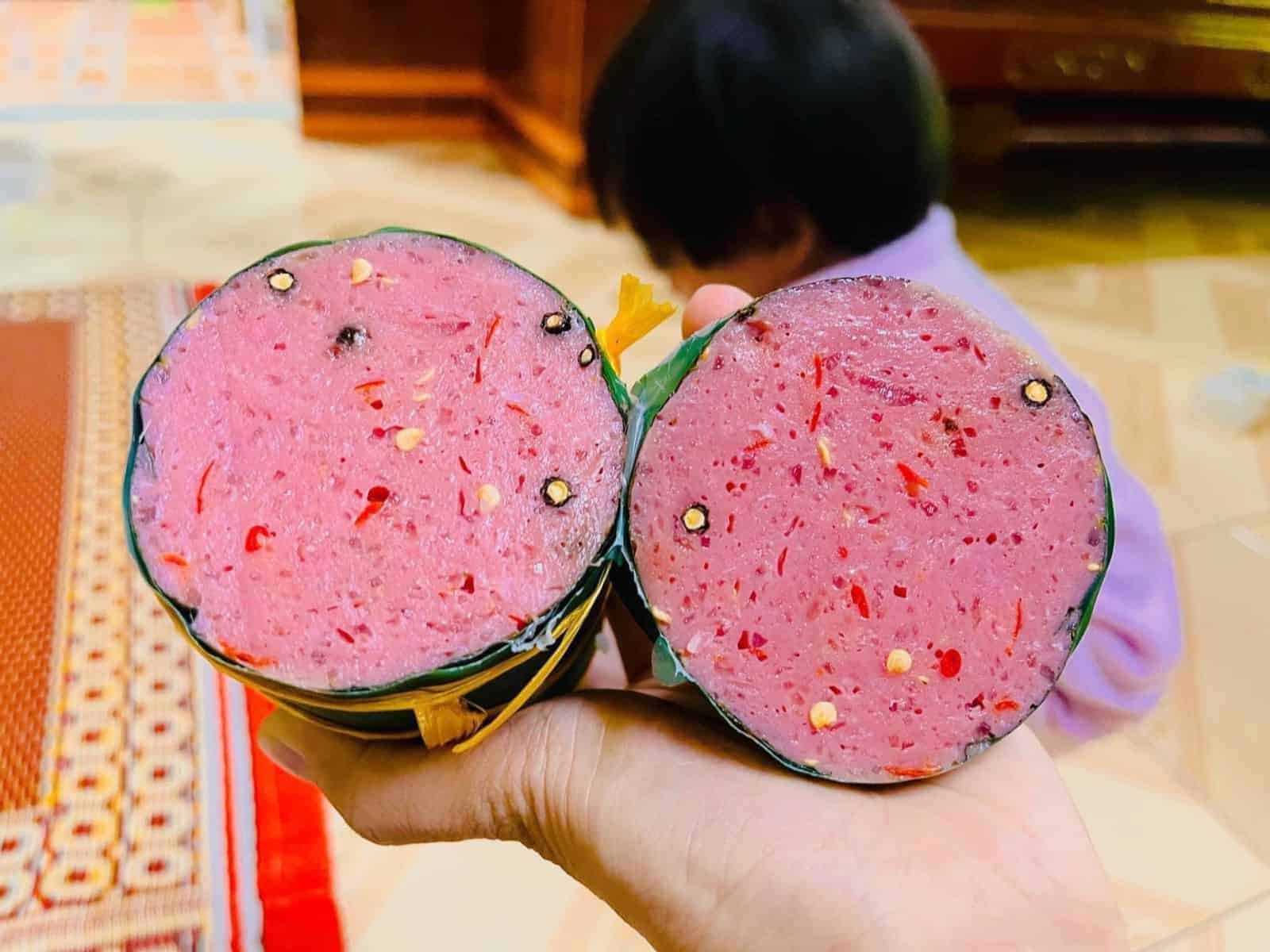
- Dưa Món (Pickled Veggies in Fish Sauce)
Dưa Món is a pickled dish popular during Tết, especially in central Vietnam. It’s a bit like Đồ Chua, made with carrots and daikon, but here the veggies are sun-dried or dehydrated before being pickled in fish sauce brine.

When Tet rolls around, my auntie makes Thịt Ngâm Mắm, and my mom takes charge of Dưa Món and Củ Kiệu.
As for me, I’m a die-hard fan of pairing Dưa Món with Bánh Chưng and Bánh Tét.
Southern Dishes
- Bánh Tét (Cylindrical Sticky Rice Cake)
Down in the South, Bánh Tét steals the spotlight during Tết. It closely resembles the Khmer dish Num Ansom. Unlike Bánh Chưng, Bánh Tét can swing both ways – savory or sweet. The sweet variant of this sticky rice cake is particularly beloved in Miền Tây (Mekong Delta).

For the savory version, Bánh Tét has a filling of pork belly and mung beans, while the sweet Bánh Tét features sticky rice cooked with coconut milk and a delightful filling of sweetened mung bean paste or banana.
- Thịt Kho Tàu (Braised Pork with Eggs)
Thịt Kho Tàu/Thịt Kho Trứng is a Tet essential for Southern people, especially in the Mekong Delta. Southern moms typically prepare a large pot of Thịt Kho Trứng one or two days before Tet, and the entire family enjoys it on Tet days.
Some Viet kids playfully claim to be tired of Thịt Kho Trứng during Tet, but deep down, they know it’s all part of the cherished tradition.

Southern moms often use coconut water and duck eggs when cooking Thịt Kho.
On my blog, I currently only have a recipe for the Northern-style Thịt Kho Tàu, given its lesser popularity on the internet but it’s just equally delicious.
- Canh Khổ Qua Dồn Thịt (Stuffed Bitter Melon Soup)
Canh Khổ Qua is like a Vietnamese comfort hug in a bowl, featuring bitter melon stuffed with a mix of ground pork, wood ear mushrooms, and bean thread noodles. It’s got that bitter kick, but trust me, it’s the good kind of bitter!

This Vietnamese soup (canh) isn’t just a regular on Vietnamese dinner tables; it’s also a Tet superstar. Why? “Khổ Qua” translates to “your hardship is already passed,” signaling that you’re leaving all the challenges of the past year behind. It’s like a flavorful fresh start!
- Củ Kiệu (Pickled Chinese Onions)
Just like how people in the central region enjoy Dưa Món , Southerners have their own love—pairing bánh tét with Củ Kiệu (pickled Chinese onions) and tôm khô (dried shrimps). My mom’s a huge fan of củ kiệu, which is why we never run out of that big jar during Tet!

Chinese-Vietnamese Dishes
In the vibrant streets of Saigon and the enchanting Mekong Delta, you’ll find a bustling community of Chinese Vietnamese. Coming mostly from South China, they belong to various ethnic groups like Cantonese (Quảng Đông), Teochew (Triều Châu), Hakka (Khách Gia), Hokkien (Phúc Kiến), and Hainanese (Hải Nam).

I once lived in the heart of Saigon’s Chinatown , fully enjoying the rich culture and delicious cuisine of the Chinese community in Chợ Lớn. The Chinese-Vietnamese are an integral part of Vietnam’s diverse population. They also have their own unique traditional foods for celebrating the Lunar New Year.
- Bánh Tổ (Nian Gao/Chinese New Year Sweet Rice Cake)
Nian Gao (年糕) is the traditional New Year sweet rice cake of Chinese people, made from sticky rice flour, ginger, and brown sugar. In Vietnam, it’s known as Bánh Tổ (Ancestor Cake).

Bánh Tổ is quite popular among Vietnamese Chinese in the South. Surprisingly, it’s also a Tet specialty among Hội An local people in the central part of Vietnam.
During the period of Nguyễn Lords, around the 16th-17th century, Hội An was a trade conduit between European, Chinese, Indian, and Japanese merchants. This multicultural environment not only influenced the local architecture and culture but also left its mark on the local cuisine.
Bánh Tổ and Cao Lầu (braised spiced pork noodle) are prime examples of this delightful culinary fusion.
- Bánh Pía (Teochew “Pia” Pastry)
Bánh Pía is a local sweet initially made by Teochew immigrants in Southern Vietnam. It boasts a flaky crust similar to puff pastry. The filling is often mung bean paste with a durian flavor. In Southern Vietnam, Bánh Pía is a specialty for festive occasions like Tết Nguyên Đán or Tết Trung Thu (Mid-autumn festival).

Today, Bánh Pía has become a year-round favorite sweet. It can be stored for an extended period, that’s why I recommend Bánh Pía as a worth-buying Vietnamese souvernir if you have a chance to visit Saigon.
- Lạp Xưởng (Lap Cheong/Chinese Sausages)
Lap Cheong (腊肠;, Lạp Xưởng in Vietnamese), the famous Chinese sausages from the Cantonese people, is a culinary delight well-known in Chợ Lớn, thanks to the substantial Cantonese community residing there.

Lạp Xưởng is a popular ingredient in daily Chinese-Vietnamese dishes like Xôi Mặn/Xôi Lạp Xưởng (sticky rice with Chinese sausages) and Bò Bía (spring rolls with Chinese sausages). During Tet, people love to grill or steam-fry it and enjoy it as a drinking dish.
- Sủi Cảo (Jiaozi/Chinese Dumplings)
Jiaozi (餃子) is the traditional dumplings often eaten during Chinese New Year, particularly in Northeastern China. In Vietnam, it’s known as sủi cảo/bánh chẻo and is also a popular dish during Tết among some Vietnamese Chinese families.

- Thịt Heo Quay (Roasted Pork Belly)
Thịt Heo Quay is another popular dish in the Lunar New Year banquet of Chinese-Vietnamese families. Some families, especially those with significant businesses, go as far as preparing a whole roast suckling pig.

In their culture, a whole pig is believed to bring good fortune to their significant family events, business openings, or as part of spiritual rituals.
Non-Traditional Dishes (But Perfect For Tết)
Living in Germany, where Tết isn’t recognized as a holiday, has made preparing traditional Vietnamese dishes a bit of a challenge for me. However, that’s what sparked the creation of Savour the Pho.
These recipes are a great fit for busy families or for bringing a refreshing touch to your Tết potluck parties.
Bánh Pate So is a French-Vietnamese dish which could be served as an appetizer or perfect for your potluck. Flaky, buttery, and delicious with juicy filling. It’s quite easy-to-prepare since we will use store-bought pastry dough.


Here’s my shortcut to the traditional Cánh Gà Chiên Nước Mắm, where I make use of my air fryer. I like to call it Vietnamese finger-licking good because the wings with sweet-savory fish sauce glaze are simply irresistible.


I’m not sure if hot pot is a traditional or non-traditional dish for Tết since my family also enjoys Lẩu (Hot Pot) during this festive time. Whether it’s Chinese or Vietnamese-style hot pot, it only takes a short time to prepare the fresh ingredients, especially when using the instant hot pot base.
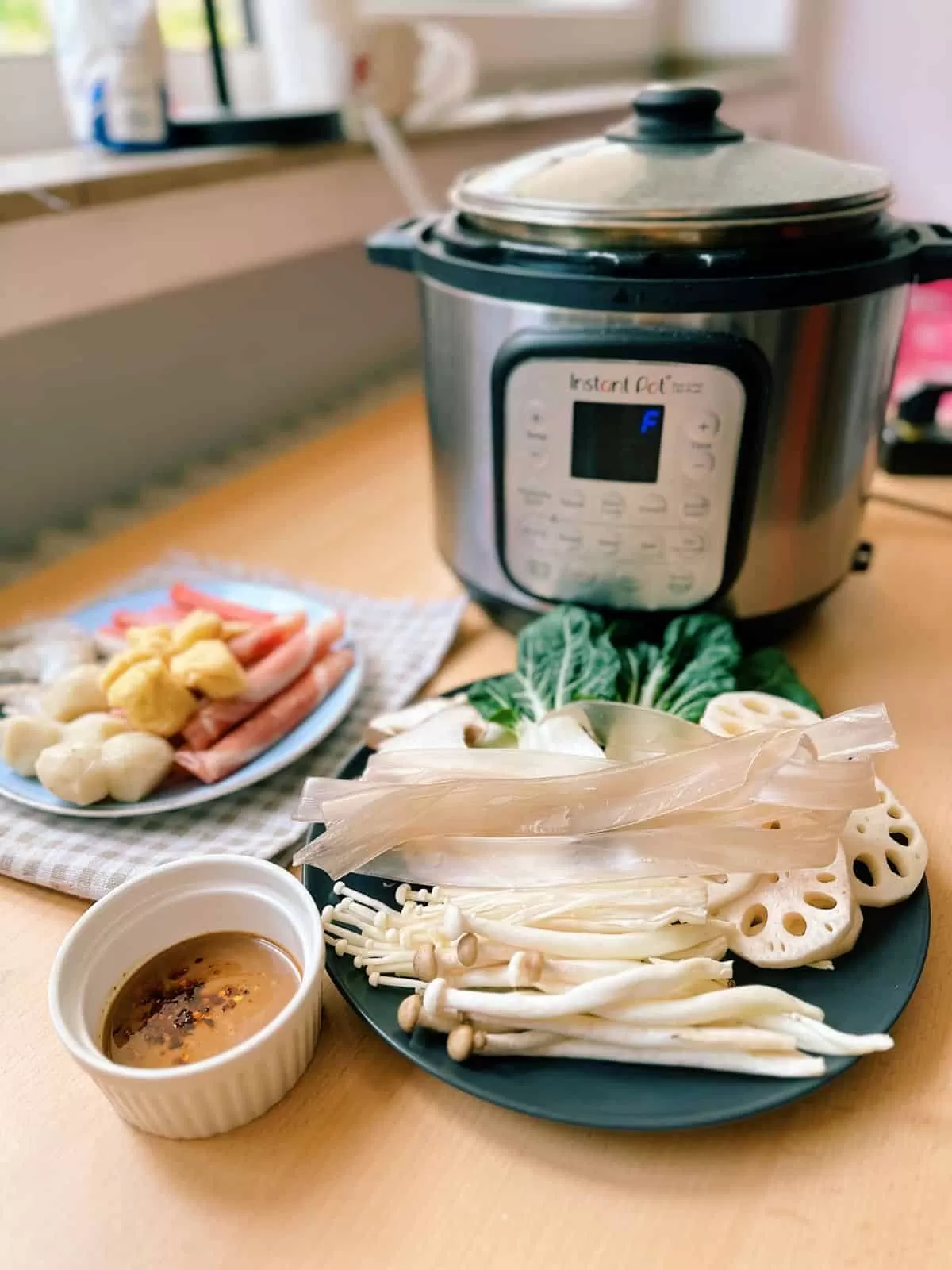
With hot pot, you can skip all appetizers and main dishes – only Lẩu is enough for your Tet party!
Note: In my recipe, I use my Instant Pot to cook hot pot, but you can definitely use an electric hot pot or a single burner with a separate pot.

This Charcuterie Board is like a Banh Mi Feast for your party. Vietnamese cold cuts are easily available at Asian markets (or you can substitute them with your favorite cold cuts if there are limited choices). Preparing Đồ Chua and Vietnamese Mayo also takes just a little while.

I also suggest making Vietnamese Liver Pâté , as it can be used for Bánh Pate So too. However, if you are busy, feel free to go with your favorite pâté.

Gỏi cuốn, a popular Vietnamese street food, is not only perfect for potlucks but can also serve as a wholesome family reunion meal. Let me guide you on how the Vietnamese turn Gỏi cuốn into a rice paper roll feast.
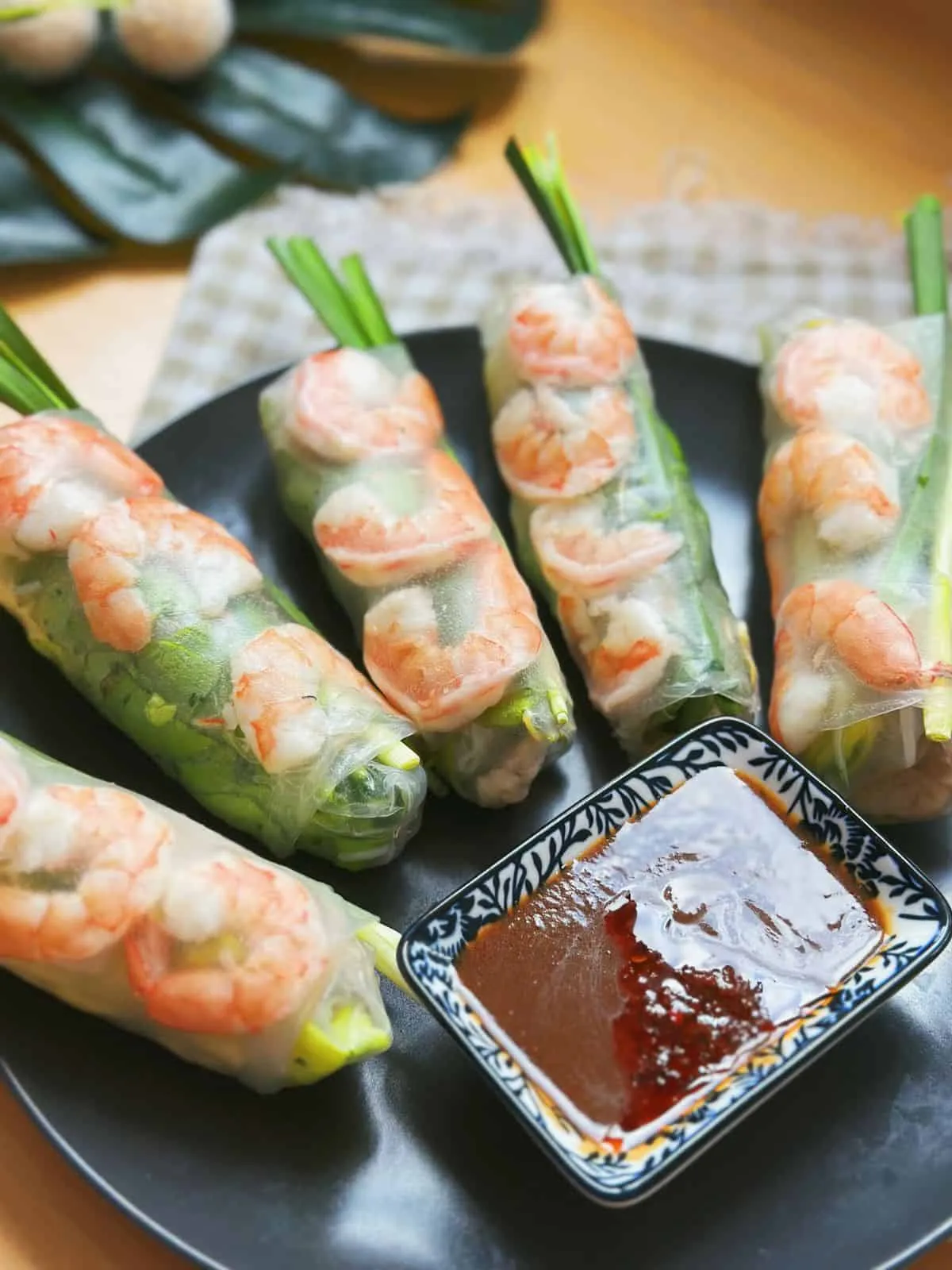
Simply prepare all the ingredients:
- Rice papers (Bánh Tráng) and some bowls of room-temperature water
- Lettuce and Vietnamese herbs like Thai basil, mint, perilla leaves…
- Filling options such as boiled pork belly, grilled lemongrass chicken, soy garlic chicken breast, or any protein of your choice, even like Japanese Teriyaki chicken.
- For dipping sauces, my nước chấm (dipping fish sauce) and hoisin peanut sauce work amazingly. Make sure to prepare the dipping sauces in surplus.
Then, show your friends or family members how to wrap spring rolls with rice papers, starting with a few initial rolls. I believe this experience will turn into a fun and communal Tet meal for your loved ones.

In Vietnam, Bánh Xèo is a great choice for a family meal. My mom always gets the batter ready in advance and cooks bánh xèo with two pans simultaneously to speed up the process.

You can even prepare Bánh Xèo ahead of time and reheat them with your air fryer before eating. They stay wonderfully crispy and delicious.
If you’re up for making Bánh Xèo right at the table and sharing the joy with family, you might want to consider trying my Banh Xeo waffles . They’re a tasty twist on this classic dish!

Bánh Khoai Mì Nướng is a popular sweet snack in Southern Vietnam. It’s an easy, quick-dump, gluten-free recipe, yet super delicious with a coconut flavor. Even my German boyfriend enjoys it, so I’m confident that all your guests will love this dessert too.
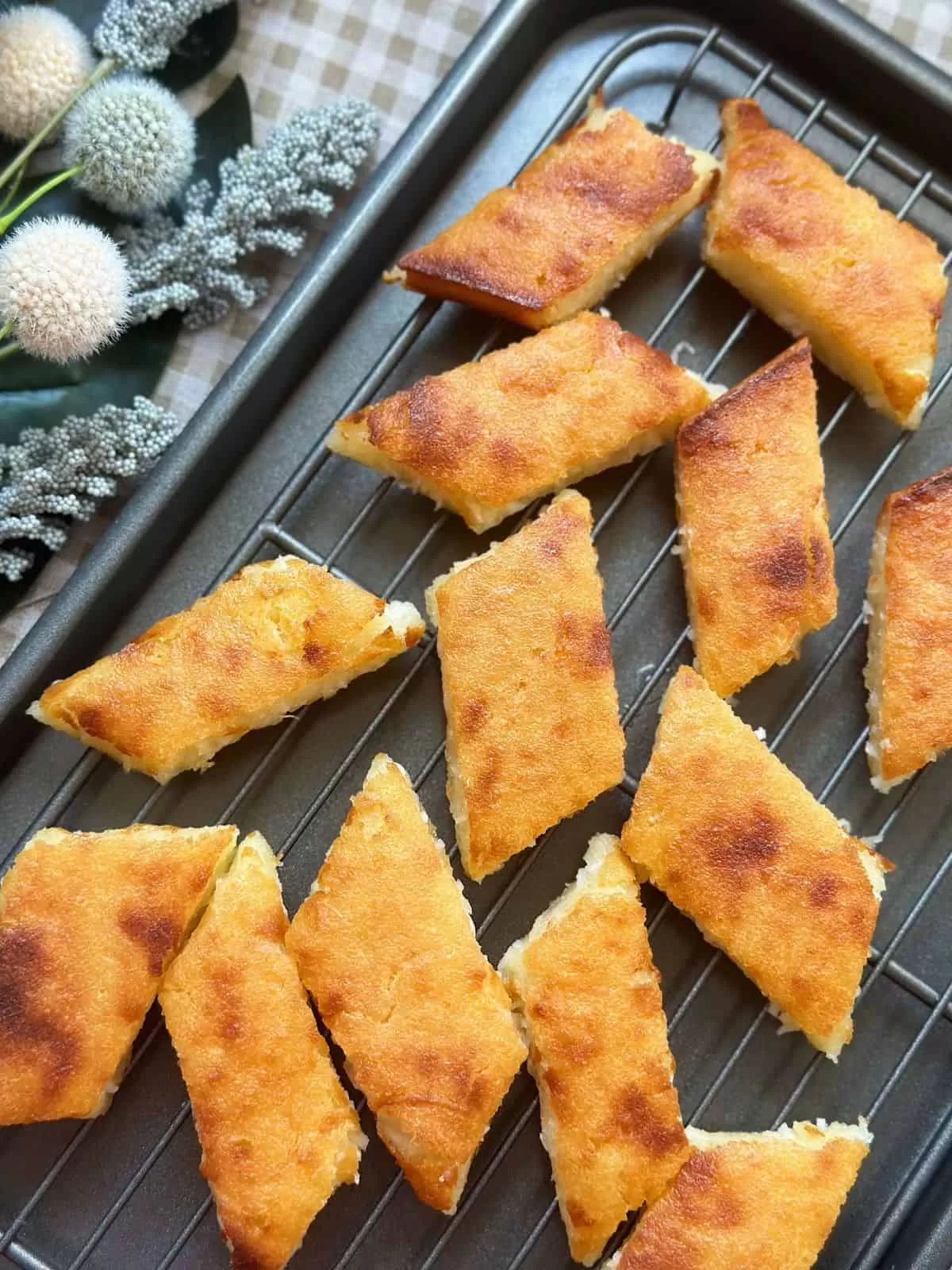

I hope this collection of traditional and modern Vietnamese dishes has given you some insights about our culture as well as some cooking inspirations for your Tết Fest. May you enjoy a delightful time preparing for this special festival.
Happy Lunar New Year! Chúc Mừng Năm Mới!



